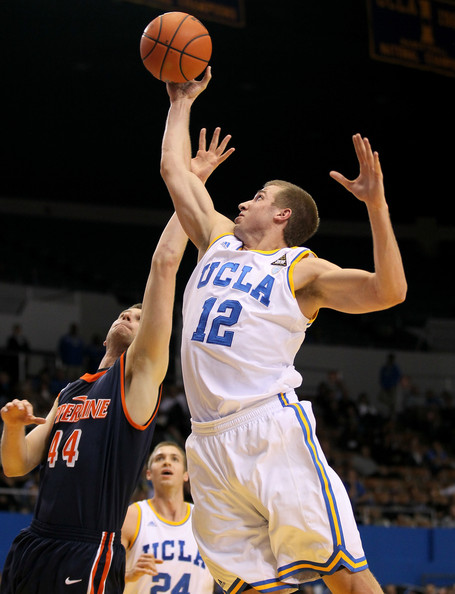A Peek Into The UCLA Pecking Order
Posted by AMurawa on November 21st, 2012With the newly eligible Shabazz Muhammad joining the rotation, it was unclear exactly how Ben Howland would fold the highly-regarded freshman into a wing-heavy lineup. Fellow freshman Jordan Adams had established himself in the first three games as the team’s best pure scorer. Sophomore Norman Powell had earned the starting two-guard spot, while last year’s incumbent Tyler Lamb was recovering from arthroscopic knee surgery. And then there’s freshman Kyle Anderson, a man without a position who is mostly a point guard (or point forward, or just a point) on the offensive end and some sort of wing player defensively. With David Wear going down with injury at the end of the semifinal game in the Legends Classic against Georgetown, the consolation game against Georgia provided a glimpse into Howland’s estimate of the strengths of his team and where the priorities may lie in his rotation. Would clear interior guys like junior Joshua Smith and freshman Tony Parker slide up the depth chart to fill the departed Wear’s spot, or would Howland find room for all his talented perimeter guys to work together.
The answer was clearly the latter, although it is open to evolve based on improvement and opposition. While Travis Wear earned 32 minutes of action, Smith and Parker combined for 19 minutes, meaning there were 11 minutes of action where UCLA had a pair of big guys on the floor. Larry Drew II is clearly locked in at the point guard, with his 5-to-1 assist-to-turnover ratio and solid defense providing plenty of ammunition for that decision, while Anderson, Muhammad, Powell and Adams are in the mix for the minutes at the two through four spots. It remains likely that Howland will opt for two big guys (meaning some combination of two of the Wears, Smith and Parker) for the majority of minutes, although last night’s game provides some precedent for going with the four-out, one-in model (not that this conglomeration of players would make for the traditional example of that style). The biggest concern brought to light by the results of last night’s game were the rebounding numbers, where Georgia made an impact on the offensive glass, especially in the second half, and the relatively undersized Bruin front line failed to regularly secure defensive rebounds.
That aside, there was one other nod by Howland towards the fact that all is not perfect in Bruin-land (aside from a unimpressive 1-1 record in Brooklyn): the 2-3 zone. For the last three seasons, Howland, a traditionally devout man-to-man coach, has been forced in the early season to experiment with the 2-3 zone out of his guys’ inability to check the opposition’s dribble penetration. Last night’s relatively brief flirtation with the zone makes it four straight years running. When Howland was taking this program to three consecutive Final Fours, it is quite possible that they didn’t run a zone for an entire possession for the entire three seasons. Those teams were built on hard-nosed, physical and athletic defense. Can Howland win with a team, no matter how talented, who struggles to defend man-on-man in the halfcourt? Looks like we’re about to find out.











































